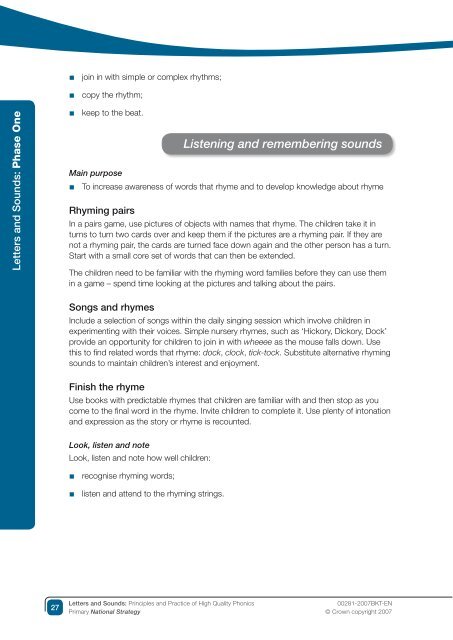Letters and Sounds 1
Letters and Sounds 1
Letters and Sounds 1
Create successful ePaper yourself
Turn your PDF publications into a flip-book with our unique Google optimized e-Paper software.
<strong>Letters</strong> <strong>and</strong> <strong>Sounds</strong>: Phase One<br />
■ join in with simple or complex rhythms;<br />
■ copy the rhythm;<br />
■ keep to the beat.<br />
Main purpose<br />
<strong>Letters</strong> <strong>and</strong> <strong>Sounds</strong>: Principles <strong>and</strong> Practice of High Quality Phonics<br />
Primary National Strategy<br />
Listening <strong>and</strong> remembering sounds<br />
■ To increase awareness of words that rhyme <strong>and</strong> to develop knowledge about rhyme<br />
Rhyming pairs<br />
In a pairs game, use pictures of objects with names that rhyme. The children take it in<br />
turns to turn two cards over <strong>and</strong> keep them if the pictures are a rhyming pair. If they are<br />
not a rhyming pair, the cards are turned face down again <strong>and</strong> the other person has a turn.<br />
Start with a small core set of words that can then be extended.<br />
The children need to be familiar with the rhyming word families before they can use them<br />
in a game – spend time looking at the pictures <strong>and</strong> talking about the pairs.<br />
Songs <strong>and</strong> rhymes<br />
Include a selection of songs within the daily singing session which involve children in<br />
experimenting with their voices. Simple nursery rhymes, such as ‘Hickory, Dickory, Dock’<br />
provide an opportunity for children to join in with wheeee as the mouse falls down. Use<br />
this to find related words that rhyme: dock, clock, tick-tock. Substitute alternative rhyming<br />
sounds to maintain children’s interest <strong>and</strong> enjoyment.<br />
Finish the rhyme<br />
Use books with predictable rhymes that children are familiar with <strong>and</strong> then stop as you<br />
come to the final word in the rhyme. Invite children to complete it. Use plenty of intonation<br />
<strong>and</strong> expression as the story or rhyme is recounted.<br />
Look, listen <strong>and</strong> note<br />
Look, listen <strong>and</strong> note how well children:<br />
■ recognise rhyming words;<br />
■ listen <strong>and</strong> attend to the rhyming strings.<br />
00281-2007BKT-EN<br />
© Crown copyright 2007
















